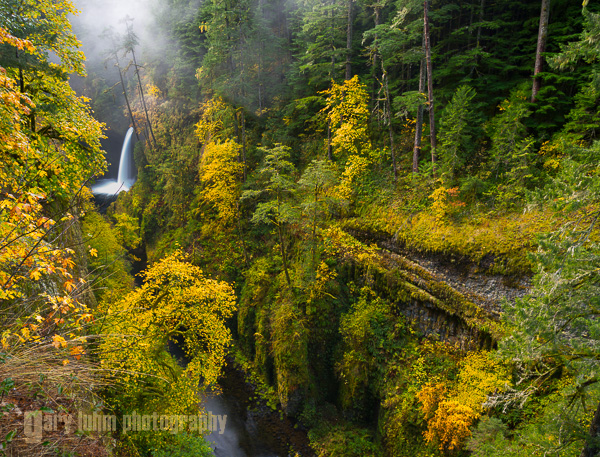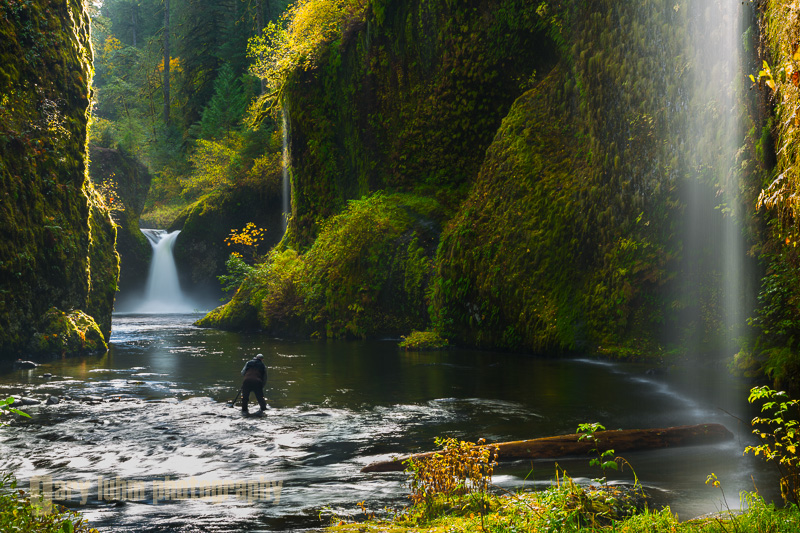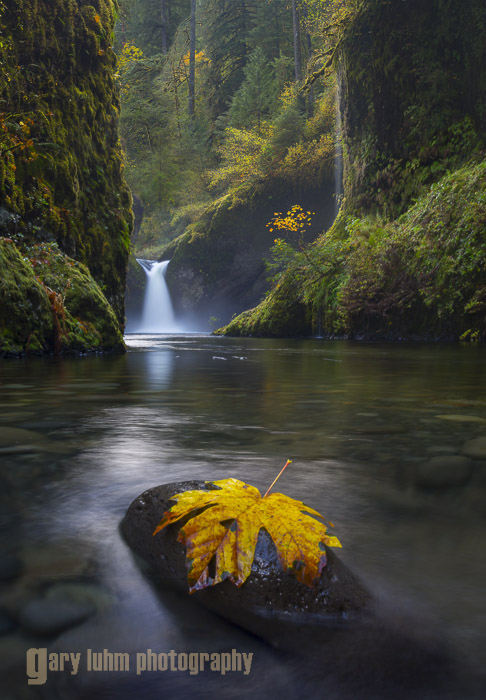
Last week we photographed at Eagle Creek in Oregon’s Columbia Gorge, a shutterbug bucket-list location that shows phenomenally well in the fall. The Columbia Gorge is slot canyons Northwest, a mesmerizing, choreographed symphony in black, yellow and green.
As with any photo shoot, photographing here requires preparation. Study the area, look at photos on-line, and make a plan. What follows are my Gorge scenic preparation tips, with a bit of “no hand-of-man” bias. I like the trails and shun the rails.
First up is where to go. The Columbia Gorge is a large area, a knife-cut through the Oregon and Washington Cascades; I like the waterfall canyons of the Oregon side. For a single-day trip, Eagle Creek never ceases to amaze. Other favorites are the lower Oneonta Canyon, Tanner Creek to Wahclella Falls, Elowah Falls and Upper Horsetail Falls. I usually pass on tourist-laden Multnomah Falls.

Second up is timing. A spring trip is best mid-April to mid-May. Fall color tops out toward the end of October, but a key factor is rainfall. A good rain fills the creeks and swells the waterfalls. Photographing in the rain can be rewarding, but your efficiency drops and it can be tough on camera gear. If you have scheduling flexibility, shoot post rain-storm; bright overcast or partly sunny skies can produce dramatic backlighting. In the Gorge canyons, forget the magic hours. If you need a sunrise or sunset, good places for that are the perch at Crown Point, or head east to the Rowena Plateau. In the canyons, basalt walls and tall timber block the sweet light, though it does pay to get up in the slots early to maximize the misty in waterfalls.
After crossing Eagle Creek, I backed up to include the water streaming in from the canyon walls. Backlighting and a polarizing filter enhance the scene, and a hat held out and above the lens prevented flare. The photographer in the image has donned hip waders, allowing him movement to just about anywhere in the basin.
Third, you need a tripod. It’s too dark trailside to shoot handheld. Moreover, slow—indeed very slow—shutter speeds of ½-sec or more transform flowing water into silky-smooth, sensuous eye-candy.
Fourth, you absolutely need a polarizing filter. A polarizer cuts the glare off wet leaves. It produces satisfying, saturated colors. It also slows shutter speed, obviating the need for a neutral-density filter.
Fifth, you need a lens hood. A hood blocks stray water drops, protects the glass, and most importantly reduces lens flare. You’re often pointing the lens upward towards a waterfall, tree canopy or cliff. Where the hood fails to protect from flare—when you’re shooting more directly into the sun or bright sky—use your hat or hand to block the worst of it.
Sixth, pack camera protection like a shower cap or plastic bags, and carry a cotton bandana. I like the shower cap for Northwest drizzle. Keep the camera on the tripod, and between shots use the shower cap to shield the camera from the wet. A bandana can be used to wipe water drops from the camera body as needed. Raingear—for your own protection—is essential as well.

Seventh, you want a wetsuit, hip waders or a drysuit—or at the very least, knee-high, waterproof boots. Pack them in, suit up, wade in and discover unique perspectives. I’ve carried such gear in a knapsack to Eagle Creek’s Punchbowl numerous times, with excellent results. Another great place for waders is a wet stroll up the Oneonta, a Northwest Upper Antelope in green (Note: On my last visit to the Oneonta, climbing over the log jam at the bottom was too intimidating, so unless that has changed, beware).
Finally, for scenic shots in general: Turn off lens stabilization when the camera is on a tripod, use your lowest ISO, lock up the mirror, and control the camera with an electronic cable release or a two-second time delay.
This “boots in the water” image was taken quite a bit forward of the stone bridge used by shooters unprepared for getting their feet wet.
Our day trip up Eagle Creek started with a glorious hike up-canyon. Yellowing Bigleaf Maples led the primetime color barrage. We stopped first at Metlako Falls, 1-½ miles from the trailhead. The canyon below the falls dripped gold, so I opted for a wide-angle view and polarizer, using the leading lines of the canyon walls to guide the eye to the Falls.
Our next stop was Punchbowl Falls, two miles in. The view of Punchbowl from the lower basin is classic, but with a photo-desirable high water flow, you’ve got to be willing to get your feet wet (old tennis shoes may work, but be prepared for cold feet). Enterprising photographers have built a stone bridge out into the channel for a view of the falls during moderately high flows, but walking out on the stones is a dicey balancing act. More importantly, photographing from the stones locks you to a single view. Hauling up the aforementioned waterproof boots or hip-waders gives you some options. I like a wetsuit or drysuit. In most flows I can safely cross the creek, for a whole new perspective. Camera and lens need to be stowed in waterproof bags to cross securely. Easiest is to put the waterproof camera bag in a backpack along with your strapped-on tripod, so the hands are free for balance. Hip waders could be used for the crossing as well, but a slip in mid-stream could flood them.

Eagle Creek has much more to offer upstream: Loowit Falls, High Bridge, fabled Tunnel Falls and more. Instead we returned to the parking lot and drove a mile west to Tanner Creek (Wahcella Falls). Close to the Tanner trailhead parking lot, rows of maples aside the creek were ripe with fall color.
It shouldn’t all be about waterfalls. This view looks up at Bigleaf Maple. Backlighting and a polarizing filter enhance a study of color and line.
More than many photo locations, preparation in the Columbia Gorge is a key to its photographic rewards. When the Gorge glistens, it’s the water. Be ready.
Gary